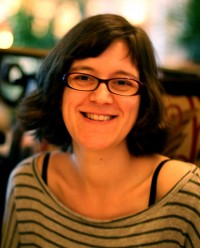
Elena Blanco of the School's Soft Matter Physics research group is investigating particle dispersion in chocolate making.
My background is in Soft Matter and I have previously worked on emulsion and foam stabilisation using surface-functionalised particles. The ability of colloidal particles to adhere to liquid-liquid or liquid-air interfaces is known as Pickering stabilisation. Pickering foams and emulsions can be remarkably stable to coalescence because of the high energies of attachment for particles held at fluid-fluid interfaces.
Complex colloids with chemically heterogeneous surface properties, unconventional shapes and morphologies play a key role in the stabilisation of foams and emulsions. Existing studies confirm that the particle layer at the fluid-fluid interface enhances Pickering stabilisation. For this reason, these colloids may be engineered to give new functionality to structured assemblies.
The science of chocolate
The project at Edinburgh is focused on understanding the properties of dense, complex dispersions of heterogeneous particles in heterogeneous fluids such as occur in the processing of chocolate.
Chocolate is a semi-solid suspension of solid particles (cocoa solids, sugar and milk proteins) dispersed in a fat continuous phase. Several factors may influence the physical and sensory properties of the final product. Chocolate has a continuous fat phase in which sugar cannot disperse, so natural surfactants like lecithin are used as emulsifiers.
Lecithin, a by-product of soya oil, is a mixture of phospholipids; their amphiphilic nature allows them to act as dispersants at the interface between hydrophilic components (such as sugar) and hydrophobic components (such as fat) to facilitate their mixing. Once the surfaces of the solid particles become coated with lecithin, the chocolate becomes more liquid-like.
Conching and rheology
Chocolate-making involves a process of mechanical agitation called conching that was developed by Rodolphe Lindt in 1879. Conching breaks agglomerates, coats the solid particles with fat and reduces the viscosity, so creating the desirable flow (rheological) properties of chocolate.
A well-defined texture is dependent upon these flow properties. Chocolate behaves as a non-Newtonian fluid presenting a yield stress (the minimum amount of stress that must be applied for flow to occur) and plastic viscosity. It is not well understood how the rheology of chocolate is affected by the interactions between the different components of chocolate and the process of conching.
Commercial application
Chocolate is a luxury food that, during consumption, evokes a range of stimuli which activate the pleasure centres of the human brain. The average consumption in many European countries is around 8kg per person per annum. This project, which is sponsored by Mars Chocolate, aims to use world-class scientific expertise to deliver top quality, pleasurable products.
In recognition of the theoretical work of Professor Peter Higgs, which led to the recent discovery of the Higgs boson and completion of the Standard Model of elementary particle physics, the University of Edinburgh is establishing the Higgs Centre for Theoretical Physics.
It will also establish a Chair in the name of Peter Higgs.
The Centre will bring together theoretical physicists from around the world to seek an even deeper understanding of how the Universe works.
The University has committed an initial sum of £750k for new academic staff, PhD studentships, and a programme of international visitors and workshops at the Centre, which will be based within refurbished space at the James Clerk Maxwell Building on the King’s Buildings campus.
“Discovery of the Higgs boson completes our picture of the known elementary particles, but these make up only 4% of the Universe. It demonstrates the power of theoretical physics to explain Nature, even though it took almost fifty years for the experimental confirmation. So we are confident that the work of the Higgs Centre can guide our search for what the rest of the Universe is made of.” Prof. Richard Kenway, Tait Professor of Mathematical Physics, University of Edinburgh
The Centre’s International Steering Committee will be chaired by Richard Kenway (Tait Professor of Mathematical Physics) and includes: Peter Higgs, John Ellis (Clerk Maxwell Professor of Theoretical Physics, King’s College, London) and James Stirling (Jacksonian Professor of Natural Philosophy, University of Cambridge). The Director will be Professor Richard Ball.
Higgs Centre for Theoretical Physics Fund
A campaign, known as the Higgs Centre for Theoretical Physics Fund, has been established to support the work of the Centre.
Donations can be made to the fund by contacting the Development and Alumni team on 0131 650 2240; emailing margaret.clift [at] ed.ac.uk or through the Higgs Centre for Theoretical Physics Fund website.
Image gallery
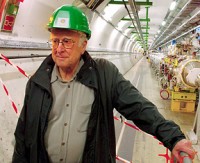
Scientists at Cern have announced results giving the strongest indication yet that the Higgs boson particle exists.
Newly analysed data from the underground facility near Geneva has discovered a new particle consistent with the Higgs boson, which was first postulated by the University’s Professor Peter Higgs.
"Scientists at Cern are to be congratulated on today’s results, which are a great achievement for the Large Hadron Collider and other experiments leading up to this." Professor Peter Higgs, Emeritus Professor, The University of Edinburgh
Tiny yet key particle
Professor Higgs developed his theory of the particle that bears his name when he was a researcher at the University in the early 1960s. Since then, the Higgs boson has formed a crucial strand of particle physics theory. It is thought to be a tiny yet key particle that enables all other particles to have mass.
Physical universe
The Higgs is a missing link in the standard model of physics, a theory that defines our understanding of the physical world. If the particle exists, it validates our understanding of fundamental physics.
"The efforts of our team at Edinburgh have helped make these results from Cern a reality. We are very proud to have contributed to these findings." Dr Victoria Martin, Lecturer, School of Physics and Astronomy
University input
Some 15 scientists from the University are involved in the research at Cern, including some whom were taught by Professor Higgs. The LHC smashes protons together at high energy, to recreate the conditions that existed just after the big bang.
Complex experiments
Under these conditions, Higgs bosons may be produced, but these decay almost as soon as they are formed. Scientists search instead for other particles left behind by the Higgs’ decay. For every billion proton collisions, about 1 Higgs bosons would expect to be seen - so scientists have to carry out myriad experiments and then dig deep into their data to find evidence of the particle.
"This is truly an exciting time and comes after many years of hard work." Dr Phil Clarke, Reader, School of Physics and Astronomy
Image gallery

Thomas Scheler, a PhD student in the Extreme Conditions group of the Institute for Condensed Matter, describes his placement at Edinburgh Instruments Ltd.
My appetite to find out more about working in industrial research was whetted by the industrial associates’ talks at last year’s careers event. This led to me taking a 7-week break from my PhD earlier this year, to work in the R&D division of Edinburgh Instruments Ltd, a medium‐sized company producing and developing, amongst other things, fluorescence spectrometers.
During my placement I was fully integrated into the daily routine and worked on developing benchmark tests for novel grating spectrometers – not dissimilar from the instruments I have been using in my PhD.
Commercial v. PhD
The differences from my PhD work that struck me were the shorter deadlines and consideration of consumer interests. Like other students, I am used to deadlines in my PhD for submitting conference abstracts, research proposals and project reports. I feel, however, that the potential consequences if I ever failed to meet these would largely be confined to me, whereas failing to meet a deadline in a company, such as delivering a product late, would be much more serious.
The focus of my work at Edinburgh Instruments was on someone else’s (ultimately a customer’s) project and delivering a fully working product, which contrasts with the longer term aims and greater freedom of my PhD. This meant spending much more time than I anticipated on user interfaces and ergonomics, things that might be considered a distraction from ‘the science’ in my PhD.
"The placement taught me a lot and I feel much better informed about the career decisions I will need to make. I strongly recommend a similar experience to other students." Thomas Scheler
I worked as part of a team of many highly-skilled individuals, most of whom had a university background, most with PhDs and some having completed postdoctoral positions before moving to industry. I enjoyed working in their team and appreciate how well integrated they made me feel. Previously, I had only experienced life in an academic environment and at national laboratories.
The Scottish Doctoral Training Centre in Condensed Matter Physics
Thomas is a student of The Scottish Doctoral Training Centre in Condensed Matter Physics, a tri-institutional collaboration between the universities of St Andrews, Edinburgh and Heriot-Watt that provides international-level doctoral training in the core discipline of condensed matter physics. It was established in December 2008 with generous funding from the UK Engineering and Physical Sciences Research Council and offers more than ten 4-year PhD fully funded studentships per annum. The first cohort of students arrived in September 2009.
Students perform a PhD research project, take graduate level courses, participate in summer schools, conferences and workshops, and receive skills training relevant to their future careers. The Centre aspires to produce rounded graduates equipped to succeed in research, academia and a wide range of industries and businesses.
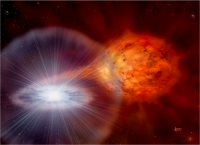
In the latest issue of the prestigious Physical Review Letters journal, School nuclear physicists report on the measurement of a nuclear reaction that is key to the understanding of type I X-ray bursts.
X-ray bursts are among the most energetic explosions in the Universe. They are triggered by a thermonuclear runaway on the surface of a neutron star that is accreting hydrogen- and helium-rich material from a less evolved companion in binary star systems.
Type I X-ray bursters (XRBs) exhibit brief recurrent bursts of intense X-ray emission and represent a frequent phenomenon in our galaxy. Recent observations from space-borne X-ray satellites (BeppoSAX, RXTE, Chandra and XMM Newton) have provided a great wealth of data and have marked a new era in X-ray astronomy. However, detailed understanding of the specific nuclear reactions responsible for such bursts is still largely hampered by the lack of experimental data relating to the energies of astrophysical relevance.
Gamow energy window
In an experiment carried out at the international TRIUMF facility in Canada, a measurement of the 18Ne(a,p)21Na reaction using the time-reversal approach was carried out at the lowest energies measured so far, and for the first time within the energy region of interest for X-ray bursts, the so-called Gamow energy window.
The results indicate a lower reaction rate (up to a factor of 2) compared with previous theoretical estimates. This will impact the physical conditions of temperature at which the thermonuclear runaway can be initiated by the 18Ne(a,p)21Na.
Nuclear Physics at Edinburgh
The Edinburgh Nuclear Physics Group is internationally renowned for its work on explosive nuclear astrophysical reactions. The project was led by Dr Marialuisa Aliotta, within an international collaboration, and formed the focus of the PhD Thesis of (now Dr) Philip Salter (Supervisors: M. Aliotta and T. Davinson).
Image gallery
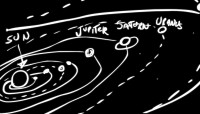
Carolyn rushes home on the train to Helensburgh to do her hobby – searching for planets orbiting other stars, exoplanets. Carolyn doesn't have a telescope but is part of the ever growing band of "citizen" astronomers who search for new planets using their computers...
The search for, and study of, planets orbiting other stars is a rapidly developing field of astronomy, and scientists and engineers based across Scotland are already taking a leading role in this exciting research. Filmmakers have become involved too, working with astronomers to produce two short documentary films to inform and inspire the Scottish public about the search for exoplanets.
‘Into Deep Space’ by Anne Milne and Alberto Iordanov
This film looks at the question of life outside of the solar system, focussing on the work of Dr Duncan Forgan – a theoretical astronomer from the Royal Observatory Edinburgh (ROE) – and Grant Miller, an observational astronomer based at the University of St Andrews. Grant uses the James Gregory Telescope in St Andrews to study exoplanets and part of Duncan’s work involves theoretical calculations and computer simulations – incorporating the latest exoplanet data – to improve our understanding of how and where we might expect to see life appearing in the Galaxy.
ECA student Alberto Iordanov said: “What an incredible journey into space! This film made me appreciate where we stand in the vast universe around us. It was a unique experience that I will remember for the rest of my life.”
“It's essential for scientists to step back from their research once in a while, and explain clearly to the public why what they're doing is important. Being in this film has really brought home to me the impact of what Scottish scientists are achieving in a very exciting field of astronomy.” Dr Duncan Forgan, Royal Observatory Edinburgh
‘Close Distance’ by Stefano Nurra and Florian Schwarz
This is a comparison of the lives of an amateur astronomer, Caroyln Bol, based in Helensburgh who is participating in the citizen science project, ‘Planet Hunters’, and Dr Martin Dominik, Royal Society University Research Fellow at the University of St Andrews. Martin uses a technique called gravitational microlensing to detect small planets orbiting other stars. The film explores the enthusiasm Carolyn, an amateur, and Martin, a professional astronomer, share for the study of exoplanets.
“We share the fascination about the myriads of pinpoints of light on the night sky. A new era of exploring new worlds not only involves professional scientists, but also amateurs, who love what they are doing, and thereby make important contributions.” Dr Martin Dominik, University of St Andrews
From Hoy to Wigtown
Emma Davie, Programme Director in the Film Department at ECA said: “Our students have had their cinematic brains challenged through searching for ways of telling stories in this hugely exciting collaboration. They've been inspired by what they found: a citizen astronomer – a woman from Helensburgh whose hobby is to sit at her computer and find exoplanets; scientists who believe that some sort of life will be found on another planet in our lifetime. How we define ‘life’ is a deeper question though...”
The films are on tour across Scotland until December 2012, and it is expected they will be seen by over 10,000 people from Hoy to Wigtown. They will be shown at a range of venues and events, from Science Centres and Cafés Scientifique, to town halls and local cinemas.
This project is a collaboration between ROE's Visitor Centre, Edinburgh College of Art (ECA), the Universities of Edinburgh and St Andrews and STFC UK Astronomy Technology Centre.
The Royal Observatory Edinburgh Visitor Centre
The ROE Visitor Centre is operated by the UK ATC, an establishment of the Science and Technology Centre. The UK Astronomy Technology Centre is the national centre for astronomical technology, designing and building instruments for many of the world's major ground-based telescopes and space observatories.
Image gallery
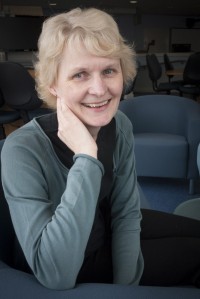
The School's Dr Judy Hardy has won a Higher Education Academy (HEA) Doctoral Programme award to extend her research into the student experience and how it can be enhanced through technology. Her project will investigate the impact and effectiveness of PeerWise, a freely available online tool that enables students to create content in the form of multiple-choice questions and explanations.
Judy has had an active research interest in physics education for many years and was one of the founder members of the Edinburgh Physics Education Research group (EdPER). Recent projects have included studies of students' expectations and experiences of using technology in their early years at university and an investigation of student-generated content for formative and summative assessment tasks.
Innovative teaching
EdPER recently introduced innovative physics teaching based on PeerWise: students can answer and comment on each other’s questions, rate questions or comments, seek help from authors and follow their favourite contributors. Devising problems, reasoning and answers can be much more demanding than ‘merely’ attempting to answer questions. PeerWise is highly engaging and interactive - in some cases students have contributed huge numbers of questions and solutions - and the approach is now being taken up in courses across the University.
Judy's research aims to understand the ways in which these types of student interactions can help promote deep learning and develop high quality problem-solving skills, both key attributes that students need to develop from an early stage in their university careers.
HEA Doctoral Programme
The HEA Doctoral Programme forms part of the Academy’s strategy to undertake research to develop pedagogical knowledge and evidence-based practice in Higher Education. Seven Doctoral studentships are available in the academic year 2012-2013.
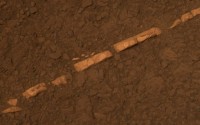
Derek Martin of the School's Physics of Living Matter group explains his work.
My background is in geomicrobiology. I have previously been involved in designing and building equipment for retrieving and sub-sampling deep sea sediment cores whilst retaining in situ pressure. This allows us to be able to manipulate sediments under anaerobic conditions at pressures of up to 1000 times atmospheric pressure.
Sub-surface microbes can be enriched, isolated and characterised without exposing them to atmospheric pressure at any point, giving us the means to attempt to isolate novel piezophiles (microbes requiring increased pressure to grow) and assess the role of microbes in biogeochemical cycles in the sub-surface.
Other areas of my research include investigating the microbial mediation of mineral precipitation; in particular, looking at the ability of bacteria to precipitate carbonates under pressure and their possible use for subsurface engineering in the context of carbon capture and storage.
Planetary simulation chamber
My work at Edinburgh will be to develop and build a planetary simulation chamber to allow us to manipulate the environmental conditions of microbial and geochemical experiments. The purpose of these experiments is to understand the potential for life beyond Earth and to gain insights into microbial physiology.
Initially this work will focus on replicating the conditions on Mars: low temperature, low pressure and high ultraviolet light flux. The intention is to be able to flow relevant fluids through the simulator and investigate the conditions under which microbes will grow, including their interaction with the rock substrate as a possible source of energy.
I will be looking at the possible composition of Mars fluids and whether the conditions have any analogues on Earth, which could help us understand whether life on Mars is possible now, or has been in the past. The intention is to extend these types of studies to the conditions present in the deep sub-surface to help us understand the role of microbes in this environment and the implications for astrobiology. It will also help us understand biogeochemical cycling in the terrestrial subsurface of Earth in the past and present, and also potentially in the future.
About the Physics of Living Matter group
The group's research in this area spans many length and time scales: from aqueous solutions of small bioactive molecules through proteins and DNA to single cells, cell-cell interactions, and collection of organisms in ecosystems, studying phenomena occurring at picoseconds to decades. It uses all three methodologies of physics: experiment, simulation and theory.
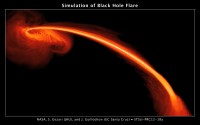
Supermassive black holes, weighing millions to billions times more than the Sun, lurk in the centres of most galaxies. These hefty monsters lay quietly until an unsuspecting victim, such as a star, wanders close enough to get ripped apart by their powerful gravitational clutches.
Astronomers have spotted these stellar homicides before, but this is the first time they can identify the victim. Using a slew of ground- and space-based telescopes, a team of astronomers – led by The Johns Hopkins University in Baltimore and including researchers from the Universities of Edinburgh, Durham and Belfast – has identified the victim as a star rich in helium gas. The star resides in a galaxy 2.7 billion light-years away.
The team’s results will appear in the online edition of the journal Nature on the 2nd of May.
“When the star is ripped apart by the gravitational forces of the black hole, some part of the star’s remains falls into the black hole, while the rest is ejected at high speeds. We are seeing the glow from the stellar gas falling into the black hole over time," research team leader Suvi Gezari, The Johns Hopkins University
“We’re also witnessing the spectral signature of the ejected gas, which we find to be mostly helium," said research team leader Suvi Gezari, of The Johns Hopkins University. It is like we are gathering evidence from a crime scene. Because there is very little hydrogen and mostly helium in the gas we detect from the carnage, we know that the slaughtered star had to have been the helium-rich core of a stripped star.”
This observation yields insights about the harsh environment around black holes and the types of stars swirling around them.
Atmosphere stripped by black hole
This is not the first time the unlucky star had a brush with the behemoth black hole. Gezari and her team think the star’s hydrogen-filled envelope surrounding the core was lifted off a long time ago by the same black hole.
The star may have been near the end of its life. After consuming most of its hydrogen fuel, it had probably ballooned in size, becoming a red giant. The astronomers think the bloated star was looping around the black hole in a highly elliptical orbit, similar to a comet’s elongated orbit around the Sun.
On one of its close approaches, the star was stripped of its puffed-up atmosphere by the black hole’s powerful gravity. The stellar remains continued its journey around the centre, until it ventured even closer to the black hole to face its ultimate demise and was completely disrupted.
Astronomers have predicted that stripped stars circle the central black hole of our Milky Way galaxy, Gezari pointed out. These close encounters, however, are rare, occurring roughly every 100,000 years.
Searching hundreds of thousands of galaxies
To find this one event, Gezari’s team monitored hundreds of thousands of galaxies with the Pan-STARRS1 telescope on Mount Haleakala, Hawaii. Pan-STARRS, short for Panoramic Survey Telescope and Rapid Response System, scans the entire night sky for all kinds of transient phenomena, including supernovae and Near Earth Asteroids, as well as the hoped for star-shredding events.
PanSTARRS was built by astronomers in Hawaii, and is operated by an international consortium, including the astronomers from Edinburgh, Durham, and Belfast. The same patch of sky was watched by GALEX, a space mission measuring ultraviolet light.
The team was looking for a bright flare in ultraviolet light from the nucleus of a galaxy with a previously dormant black hole. They found one in June 2010, which was spotted with both telescopes.
Both telescopes continued to monitor the flare as it reached peak brightness a month later, and then slowly began to fade over the next 12 months. The brightening event was similar to that of a supernova, but the rise to the peak was much slower, taking nearly one and a half months.
“The longer the event lasted, the more excited we got, since we realized that this is either a very unusual supernova or an entirely different type of event, such as a star being ripped apart by a black hole,” said team member Armin Rest of the Space Telescope Science Institute in Baltimore, Md.
By measuring the increase in brightness, the astronomers calculated the black hole’s mass to be several million suns, which is comparable to the weight of our Milky Way’s black hole.
Glowing helium
Spectroscopic observations with the Multiple Mirror Telescope (MMT) Observatory on Mount Hopkins in Arizona showed that the black hole was swallowing lots of helium. Spectroscopy divides light into its rainbow colours, which yields an object’s characteristics, such as its temperature and gaseous makeup.
“The glowing helium was a tracer for an extraordinarily hot accretion event,” Gezari said. “So that set off an alarm for us. And, the fact that no hydrogen was found set off a big alarm that this was not typical gas. You can’t find gas like that lying around near the centre of a galaxy. It’s processed gas that has to have come from a stellar core. There’s nothing about this event that could be easily explained by any other phenomenon.”
The observed speed of the gas also linked the material to a black hole’s gravitational pull. MMT measurements revealed that the gas was moving at more than 20 million miles an hour (over 32 million kilometres an hour). However, measurements of the speed of gas in the interstellar medium reveal velocities of only about 224,000 miles an hour (360,000 kilometres an hour).
“As the object faded, it stayed hot, so we knew it wasn’t a supernova because they cool down. The ultra-fast gas velocity is something we also see in Active Galactic Nuclei – but seeing only helium was like nothing I’ve ever seen in an active nucleus," Andy Lawrence, a team member from the University of Edinburgh.
To completely rule out the possibility of an active nucleus flaring up in the galaxy, the team used NASA’s Chandra X-ray Observatory to study the hot gas. Chandra showed that the characteristics of the gas didn’t match those from an active galactic nucleus.
“This is the first time where we have so many pieces of evidence, and now we can put them all together to weigh the perpetrator (the black hole) and determine the identity of the unlucky star that fell victim to it,” Gezari said. “These observations also give us clues to what evidence to look for in the future to find this type of event.”
Find out more
For images, video, and more information about this study, see:
http://hubblesite.org/news/2012/18
Image gallery

The School's Dr Rosalind Allen is part of an international team of researchers that has been awarded $1.2m to study how bacterial cells self-assemble into 3-D spatially-organized structures. It will also investigate how the different structures influence cooperation within the assembly.
Intercellular cooperation is one of the most important functional behaviours of multicellular assemblies, but from an evolutionary perspective it is also one of the least understood. Experiments and computational modelling will be used to explore self-assembly in Pseudomonas aeruginosa, a common human pathogen that readily forms assembled structures called biofilms.
The team hopes to uncover some of the “design rules” of bacterial self-assembly by manipulating the initial cell configuration of their samples and then tracking how the biofilms form over time. The team will explore, for example, whether certain spatially-structured biofilms are more cooperative and more resistant to invasion by “cheats,” which are cells that reap the benefits of cooperation without paying the costs.
"I am very excited about this grant because it gives us a great opportunity to do really interesting international and multidisciplinary research, which could be relevant not just to how bacteria assemble but also to how biological cells build 3D structures in general." Dr Rosalind Allen, Institute for Condensed Matter and Complex Systems
The P. aeruginosa research will focus on gaining fundamental understanding of how cells assemble into 3D structures, rather than on specific applications. But it is hoped that knowledge of how to design cell assemblies will benefit biotechnology and medicine in the long-term. For example, it might be possible to design surgical implants that are resistant to colonisation by the bacteria that cause chronic infections.
The computational modelling will be carried out by the School's Institute for Condensed Matter and Complex Systems (ICMCS), where it will link with the Institute's ongoing investigation into microbial population dynamics. The work also links to an EPSRC-funded collaboration with Kevin Stratford of EPCC and Davide Marenduzzo of ICMCS, which is developing computational tools for rare event simulations.
The multidisciplinary team is led by Dr Vernita Gordon of the University of Texas at Austin (Physics) and also includes Dr Thomas Bjarnsholt (University of Copenhagen, Microbiology) and Dr Steve Diggle (University of Nottingham, Biomolecular Sciences).
The $1.2m Young Investigator grant was made by the Human Frontier Science Program (HFSP), an international NGO funded by the governments of the G7 nations. HFSP provides research grants to teams of scientists from different countries who wish to combine their expertise to approach questions that could not be answered by individual laboratories. Emphasis is placed on novel collaborations that bring together scientists from different disciplines to focus on problems in the life sciences.

